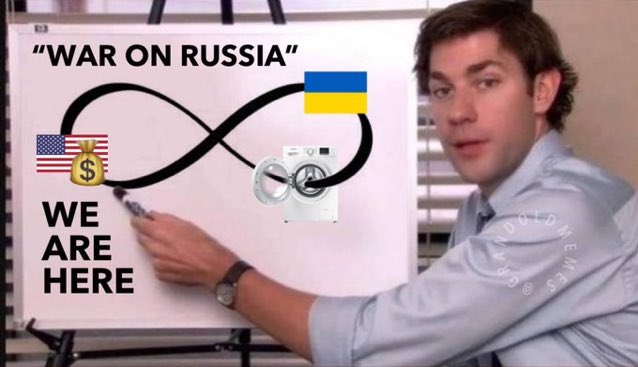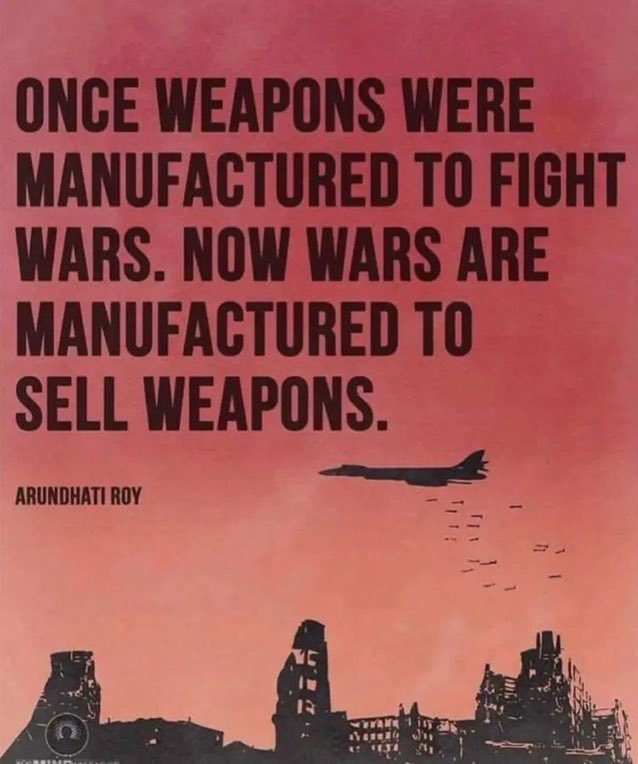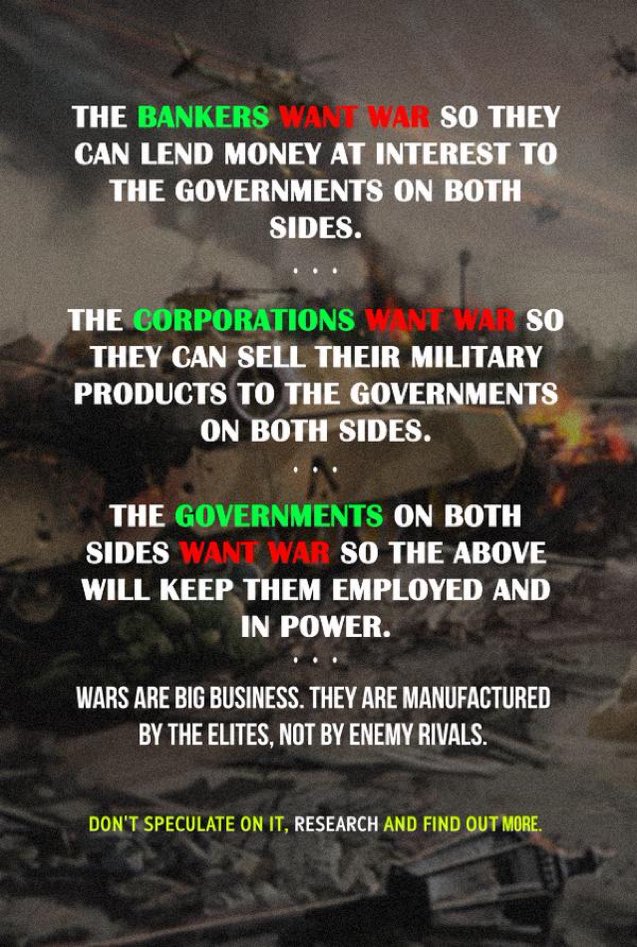Russia is a war monger. I can’t believe that Russia is destroying Ukraine like this, bombing cities & killing millions.
Putin is a mad man, who lies to everyone in the world about everything. He must be stopped.
EXCEPT THIS WAS USA DESTROYING IRAQ 🇮🇶 20 … twitter.com/i/web/status/1…
Putin is a mad man, who lies to everyone in the world about everything. He must be stopped.
EXCEPT THIS WAS USA DESTROYING IRAQ 🇮🇶 20 … twitter.com/i/web/status/1…
WMDS WERE ALL USA PROPAGANDA AND LIES TO MAKE PEOPLE BELIEVE SADDAM HUSSAIN WAS A MAD MAN KILLING HIS OWN PEOPLE
https://twitter.com/StefSimanowitz/status/1620124404637114368
Here’s a prev 🧵 on war mongering
https://twitter.com/DeepBlueCrypto/status/1635711261781393428
What USA did to Libya 🇱🇾 and Gaddafi was brutal. Zero indictments, zero war crimes. ICC was totally silent.
https://twitter.com/DeepBlueCrypto/status/1598044699985866752
George Bush lied about WMDs to drag you into war against Iraq 🇮🇶
Iraq got destroyed, looted, and it’s a total chaos still after 20 years
Zero indictments, zero war crimes
Iraq got destroyed, looted, and it’s a total chaos still after 20 years
Zero indictments, zero war crimes
#MilitaryIndustrialComplex
⚫️ Who benefits from it
⚫️ Who loses from it
Think twice before signing up for wars
⚫️ Who benefits from it
⚫️ Who loses from it
Think twice before signing up for wars

No audits for the Pentagon
No audits for the Federal Reserve
No audits for the Ukraine war funding
Essentially the taxpayers keep paying taxes while they spend money in their merry ways amassing billions
No audits for the Federal Reserve
No audits for the Ukraine war funding
Essentially the taxpayers keep paying taxes while they spend money in their merry ways amassing billions

Remember Afghanistan… USA was fighting Taliban it weaponized and trained itself. Remember when Taliban occupied Kabul again, US personnel, staff and troops had to leave in emergency. USA were there for 22 years, spent $2.5-$5 trillion and eventually had … twitter.com/i/web/status/1…
IF TRUTH IS TREASON IN AN EMPIRE OF LIES, THEN THE EMPIRE IS DOOMED
#FreeAssange #FreeAssangeNOW
#FreeAssangeTODAY #FreeSnowden
#FreeAssange #FreeAssangeNOW
#FreeAssangeTODAY #FreeSnowden

Cuba 🇨🇺 President DIAZ CANEL: "The real culprit in this Russia Ukraine conflict is the United States itself... when the US has a crisis situation like the one it has right now, it resorts to war to solve the crisis, and it puts the interests of the MIC … twitter.com/i/web/status/1…
Putin says he is ready to move forward with China's peace proposal when the West is ready. However, the United Kingdom's announcement of sending tanks and depleted uranium shells means that if the West uses nuclear-based weapons, Russia will have to react … twitter.com/i/web/status/1…
USA should stop going to wars again. Look at all the wars with small countries they lose badly with
- American revolution 1775-1783
- Korean War 1950-1953
- Vietnam 🇻🇳 1955-1975
- Afghanistan 🇦🇫 2000-2021
…
- American revolution 1775-1783
- Korean War 1950-1953
- Vietnam 🇻🇳 1955-1975
- Afghanistan 🇦🇫 2000-2021
…

Even though George Bush slipped his tongue, he got it right about himself 😂
Bush is a war monger
Bush is a war monger
Be sensible and not push your country into nuclear war… because the choices are bleak for everyone on the planet
#MilitaryIndustrialComplex must be averting nuclear confrontations at all costs
#MilitaryIndustrialComplex must be averting nuclear confrontations at all costs
There was a coup in 2014 in Ukraine. It was completely led by the west under Obama administration.
End the #MilitaryIndustrialComplex 
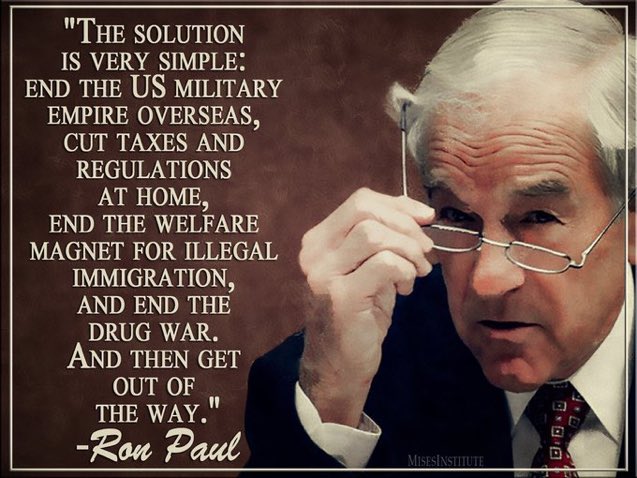
Joe Biden on supporting the NATO alliance… IF THEY ATTACK ONE, THEY ATTACK ALL…
Freaking War Monger
Freaking War Monger
Why do Russians support Putin even though he’s an authoritarian
https://twitter.com/DeepBlueCrypto/status/1627988292774887424
Biden administration left all these military equipment in the hands of Taliban in Afghanistan before leaving 

Macron Says France Can't Afford to Pay Pensions as Is — After Bumping Up Aid to Ukraine in January. France is now covered with protests and strikes because Macron said there's no money to allow workers to retire at 64.
Amazing. We always have money for … twitter.com/i/web/status/1…
Amazing. We always have money for … twitter.com/i/web/status/1…
Taliban Releases Video of Fields of US Military Vehicles, Piles of US High-End Weapons, and Rooms Filled with Stacks of 100 Dollar Bills surrendered by Joe Biden when USA left Afghanistan in a hurry after Taliban captured Kabul
Hey @elonmusk look what Ukraine is using your @SpaceXStarlink satellite with to attack Russian soldiers with chemical agent gas grenades.
https://twitter.com/KimDotcom/status/1640150010468900864
Your government “accidentally” loses trillions of dollars in Afghanistan 🇦🇫, but they want to know if anyone sends you $600. Don’t forget to report all transactions and pay your taxes. Other countries like Ukraine, Afghanistan depend on it. 

For Gods sake why the f•ck does US change regimes all over the world. It’s not as if US has a good regime. Biden administration is one of the worst in recent times. They’re worthless, woke, mindless, war mongering, media suppressing piece of crap police state to begin with 🤷♂️
https://twitter.com/SouthAsiaIndex/status/1640330796320866304
The state and mainstream media collude to spin almost every story into Russian disinformation or Putin’s fault.
The #DeepState wants to bring down Putin and change the Russian regime at all costs. They keep funding the Ukraine war every chance they get. Both Republicans &… twitter.com/i/web/status/1…
The #DeepState wants to bring down Putin and change the Russian regime at all costs. They keep funding the Ukraine war every chance they get. Both Republicans &… twitter.com/i/web/status/1…

Nelson Mandela about the United States of America. Nothing has changed. The US Govt has killed over 20 million people in 37 victim nations since WW2.
Hollywood actor Orlando Bloom meeting greatest of all Ukraine actor Zelensky… praising him 🤮
The fastest way to stop sending our sons and daughters to fight in Ukraine is to start volunteering the politicians and bureaucrats sons and daughters. 
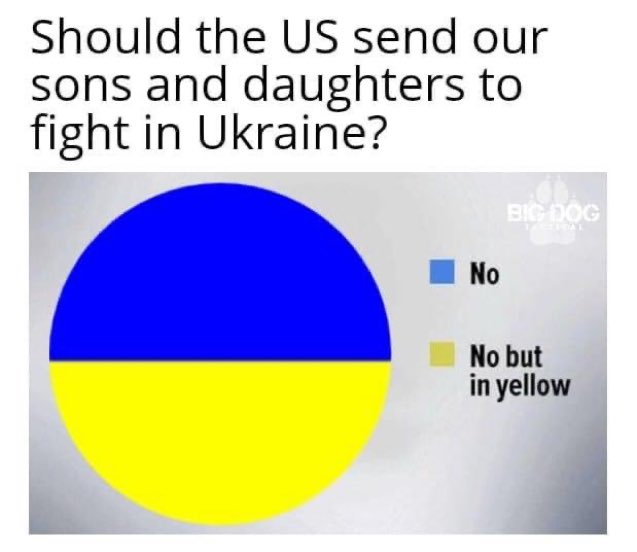
People: How can we account for all the money we send to Ukraine?
Administration: It is a war… wars can be chaotic… we cannot literally account for equipment each soldier takes into the battlefield
WHY THE FCUK ARE WE FUNDING THE WAR THEN DAMMIT
Administration: It is a war… wars can be chaotic… we cannot literally account for equipment each soldier takes into the battlefield
WHY THE FCUK ARE WE FUNDING THE WAR THEN DAMMIT
Taxpayers pay $1,000,000,000,000 per year for funding the most powerful military on earth and they seem to be enjoying drag shows 😂
Matt Gaetz drops MOAB on woke military Gen. Milley and Austin over Drag Queen story hours on US military bases — his … twitter.com/i/web/status/1…
Matt Gaetz drops MOAB on woke military Gen. Milley and Austin over Drag Queen story hours on US military bases — his … twitter.com/i/web/status/1…
$200 billion to Ukraine war funding, while our cities like Philadelphia look like war zones
A government dropping nuclear bombs on its own people just to see what happens is absolutely disgraceful.
Did you know that a vast majority of people exposed didn’t die of natural causes.
Did you know that a vast majority of people exposed didn’t die of natural causes.
https://twitter.com/dom_lucre/status/1641233937094647812
Be like Austria 🇦🇹, not like USA 🇺🇸
https://twitter.com/DC_Draino/status/1641460610591342592
They lied about Iraq
They lied about Libya
They lied about Afghanistan
Now they’re telling the truth on Ukraine and we must believe them.
We need peace and we need it now.
They lied about Libya
They lied about Afghanistan
Now they’re telling the truth on Ukraine and we must believe them.
We need peace and we need it now.
https://twitter.com/sahouraxo/status/1641513547560542242
EU is the biggest loser in this Ukraine proxy war that’s been going on.
Sanctions on Russia didn’t do shit. In fact their alliance with China and BRICS solidified their position even more than before.
EU is left with huge #EnergyCrisis 1000s of bankruptcies and severe economic… twitter.com/i/web/status/1…
Sanctions on Russia didn’t do shit. In fact their alliance with China and BRICS solidified their position even more than before.
EU is left with huge #EnergyCrisis 1000s of bankruptcies and severe economic… twitter.com/i/web/status/1…

When do we think we print the next batch of freshly minted $100 billion of Americans sweat and blood to Ukraine 

Happy #AprilFoolDay from US woke Military. Woke Military isn’t a joke 😂 



If Robin Williams is right most of our politicians except @RonPaul and a select few others should wear sponsor jackets with all these defense corps
- Lockheed Martin
- Northrop Grumman
- Boeing
- General Dynamics
- Raytheon
- BAE Systems
- L3Harris Corp
- Huntington Ingalls
-… twitter.com/i/web/status/1…
- Lockheed Martin
- Northrop Grumman
- Boeing
- General Dynamics
- Raytheon
- BAE Systems
- L3Harris Corp
- Huntington Ingalls
-… twitter.com/i/web/status/1…

This would threaten Putin further from backing down from Ukraine as he sees the enemy encroaching nearby. 

International law means nothing if it benefits one side and cheats the rest. Unless the law is equal, it doesn’t mean anything.
https://twitter.com/sahouraxo/status/1642619501765185536
What your president Joe Biden shows vs. what he doesn’t want you to know
#MilitaryIndustrialComplex must be defeated by stopping all ongoing wars, cut the military budget in half, stop NATO expansion, not enlisting yourself and your family into the military.

#MilitaryIndustrialComplex must be defeated by stopping all ongoing wars, cut the military budget in half, stop NATO expansion, not enlisting yourself and your family into the military.


Finland 🇫🇮 joining NATO further triggered Russia into a more defensive position. War isn’t going to end soon. 

🔥🔥🔥🔥🔥🔥🔥🔥
SOUTH AFRICA won’t cooperate with the ICC arrest warrant for Putin. The PM says Tony Blair, Bush & Obama are bigger war criminals.
“The whole world stands against Putin” they said… but we don’t.
Unless the ICC holds law equally for all sides, ICC laws are… twitter.com/i/web/status/1…
SOUTH AFRICA won’t cooperate with the ICC arrest warrant for Putin. The PM says Tony Blair, Bush & Obama are bigger war criminals.
“The whole world stands against Putin” they said… but we don’t.
Unless the ICC holds law equally for all sides, ICC laws are… twitter.com/i/web/status/1…
The arrest of #DonaldTrump has set a new precedent for others 

ICC is a joke. International justice is a joke as long as there are western vested interests get away with murder & genocide of millions while indicting the east for crimes 🤷♂️
https://twitter.com/KimDotcom/status/1643631435494969346
Follow @iluminatibot 

#DeepState puppet war monger Joe Biden knows very well the consequences of pushing NATO into the Baltic countries and did so willingly
https://twitter.com/KanekoaTheGreat/status/1643841339141025793
"Barack Obama murdered an American citizen, and he got no charges."
They gave #BarackObama a Nobel F••king Peace prize and still no indictments #CollateralDamages
They gave #BarackObama a Nobel F••king Peace prize and still no indictments #CollateralDamages
Best the left could do #TransForce 

French Ex-President Francois Hollander admits the #MinskAccords were a NATO ruse to militarize Ukraine. The west overthrew Ukraines democratically elected government in 2014.
https://twitter.com/kanekoathegreat/status/1644063578415308800
• • •
Missing some Tweet in this thread? You can try to
force a refresh

